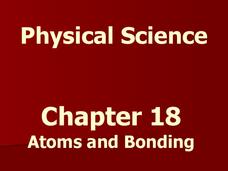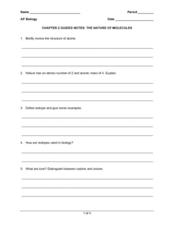Curated OER
Naming Binary Compounds
In this naming binary compounds instructional activity, high schoolers are given 8 pairs of ions and they identify their oxidation numbers, their formula when the combine and the name of the compound. They are given 8 formulas and they...
Curated OER
Naming and Covalent Compounds
For this naming and covalent compounds worksheet, students name 12 compounds using a chart of polyatomic ions if needed. They also draw covalent bonds in 6 compounds and answer 6 questions about ionic bonds, covalent bonds and polyatomic...
Curated OER
H2O2 Decomposition Lab II
Students conduct an oxidation experiment in which they must determine how much hydrogen peroxide (H2O2) is actually in a store-bought solution of H2O2.
Curated OER
Electron Dot Structures/Lewis Structures
In this elements worksheet, students practice drawing electron dot structures for atoms. Students draw the Lewis Structures for molecules with single and multiple bonds plus polyatomic ions. This worksheet has 33 problems to solve.
Mr. E. Science
Atoms and Bonding
I don't trust atoms because they make up everything. Budding scientists learn about famous scientists connected to atomic models, chemical, ionic, and hydrogen bonds. The presentation also presents how to count atoms...
It's About Time
Chemical Names and Formulas
Abracadabra! Provide your class with the tools to perform a chemical "magic show" as they predict the charges of various ions, determine ionic compound formulas, and make observations to determine when a chemical reaction between...
Curated OER
2000 U.S. National Chemistry Olympiad Local Section Exam
This 60-question comprehensive exam was designed to determine who would go on to compete in the 2000 US National Chemistry Olympiad. Hopefuls answer multiple choice questions regarding all chemistry topics taught in the first year...
Curated OER
Covalent and Ionic Bonding:Electron Dot Structures with Ionic Notation
After drawing the valence electron distribution of 13 basic elements, there are spaces to draw 18 more complicated molecules. For each molecule, there is space for a Dot structure and Lewis structure that best describes the...
Royal Society of Chemistry
pH and pOH
Feeling a little neutral about your pH and pOH teaching strategy? Perk it up with engaging puzzles! Young scientists relate ion concentration to pH and pOH, as well as the dissociation constant for water. The resource is available as an...
Curated OER
Chemistry 115 Practice Exam 3
Radioactive decay, pH, properties of elements, organic compounds, and stoichiometry are all touched upon through this practice chemistry exam. It always helps learners to take a practice test in preparation for the actual exam. This...
Curated OER
Unit 7 Acid and Base
A series of 25 multiple choice questions is presented to chemistry learners to review properties of acids and bases. A page of notes precedes the questions and contains information about the Arrhenius and Bronsted-Lowry definitions,...
Curated OER
Practice Final
A full-fledged practice final prepares pupils for their general chemistry final exam. If they complete these 57 multiple-choice questions correctly, they will be well-prepared. Note: even though the questions are multiple-choice, there...
Curated OER
The Nature of Molecules
Even though the questions on this worksheet pertain to general chemistry, it was created for an AP biology course. It is crucial for biology learners to grasp these concepts as a foundation for biochemical processes that they will...
Curated OER
Electrolysis of Water
Ninth graders examine the electrolysis of water by completing an experiment. In this water lesson students will explain how hydrogen can be extracted from water and how energy flows through an electrolysis system.
Curated OER
Acids and Bases, strong and weak pH
Lists of facts to consider and equations to use when working with Acids and Bases are very well detailed in this presentation. Students can make notes while viewing to review acids and bases. Many of these facts will stimulate further...
Curated OER
Calculating pH
In this pH worksheet, students are given information and directions as to how to calculate the pH of solutions. They use their calculators to find the pH of given solutions and apply what they learned about identifying acids and bases.
Curated OER
The Action of A Buffer Solution
In this buffer solution worksheet, high schoolers experiment with the addition of different solutions to a buffer solution and observe the changes in pH using a pH probe. Students describe the differences among the addition of pure water...
Curated OER
Household Chemistry
Students use indicator paper to determine if substances are acidic, basic, or neutral. They test for Ph levels in them. They investigate the effect of oxygen on darkening fruit cut and exposed to the air. They observe vitamin C as an...
Royal Society of Chemistry
Some A-level Reagents
Learning names and formulas can be a daunting task for young chemists, so support their study with interactive puzzles! First, users match each formula with its correct name. Then, individuals use them to complete three logic games.
Curated OER
Interpreting Chemical Formulas
In this chemical formulas worksheet, students determine the number and type of each atom and the total number of atoms for the given formulas. Students complete 10 problems.
Curated OER
Periodic Table
In this periodic table and elements learning exercise, high schoolers review valence electrons, octet rule, oxidation number, and the difference between metals and non-metals on the periodic table. This learning exercise has 5 matching,...
Curated OER
Denaturing Proteins
High schoolers investigate how to denature proteins. In this denaturing protein lesson plan, students explore the different ways to denature proteins in the lab. They use heat, acids and bases, organic compounds and heavy metals to...
Curated OER
Vocabulary - Acids and Bases
In this acids and bases worksheet, students write in the definitions for 20 terms associated with acids and bases, including buffer, pH, and equilibrium.
Curated OER
Structure of the Atom
Students practice drawing the atomic structure of several different elements. They complete critical thinking questions about atomic structure and compare the atomic mass units for different ions and isotopes of an element.

























